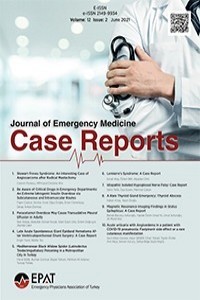Düşük Molekül Ağırlıklı Heparin Tedavisinin Nadir Komplikasyonu: Mesane Hematomu
Low-molecular-weight heparin, bladder hematoma, acute renal failure
A Rare Complication of Low-Molecular-Weight Heparin Therapy: Bladder Hematoma
___
- Gould MK, Dembitzer AD, Doyle RL, Hastie TJ, Garber AM. Low-molecular- weight heparins compared with unfractionated heparin for treatment of acute deep venous thrombosis. A metaanalysis of randomized, controlled trials. Ann Intern Med 1999; 130: 800-9. [CrossRef]
- Weitz JI. Low-molecular-weight heparins. N Engl J Med 1997; 337: 688-98. [CrossRef]
- Lensing AW, Prins MH, Davidson BL, Hirsh J. Treatment of deep venous thrombosis with low-molecular-weight heparins. A meta-analysis. Arch Intern Med 1995; 155: 601-7. [CrossRef]
- Siragusa S, Cosmi B, Piovella F, Hirsh J, Ginsberg JS. Low-molecular weight heparins and unfractionated heparin in the treatment of patients with acute venous thromboembolism: results of a meta- analysis. Am J Med 1996; 100: 269-77. [CrossRef]
- The Columbus Investigators. Low-molecular-weight heparin in the treatment of patients with venous thromboembolism. N Eng J Med 1997; 337: 657-62. [CrossRef]
- Spinler SA, Nawarskas JJ. Low-molecular weight heparins for acute coronary syndromes. Ann Pharmacother 1998; 32: 103-10. [CrossRef]
- Ji H, Li SP, Cheng X, Cheng HR, Ng TB, Li P, Li NS. Antithrombotic effects of low-molecular-weight heparin calcium (LMWH-Ca) in experimental models. Gen Pharmocol 1999; 33: 207-11. [CrossRef]
- Menzin J, Richner R, Huse D, Colditz GA, Oster G. Prevention of deep-vein thrombosis following total hip replacement surgery with enoxaparin versus unfractionated heparin: a pharmacoeconomic evaluation. Ann Pharmacother 1994; 28: 271-5.
- Deep K, Jigajinni MV, McLean AN, Fraser MH. Prophylaxis of thromboembolism in spinal injuries-results of enoxaparin used in 276 patients. Spinal Cord 2001; 39: 88-91. [CrossRef]
- Cardiovascular Disease Educational and Research Trust; Cyprus Cardiovascular Disease Educational and Research Trust; European Venous Forum; International Surgical Thrombosis Forum; International Union of Angiology; Union Internationale de Phlébologie. Prevention and treatment of venous thromboembolism-International Consensus Statement (ICS). Guidelines according to scientific evidence. Int Angiol 2006; 25: 101-61.
- Yayın Aralığı: 4
- Başlangıç: 2010
- Yayıncı: Alpay Azap
Boğulmuş Kesi Fıtığını Taklit Eden Karın Duvarı Endometriozisi Olgusu
Murat Özgür KILIÇ, Gürkan DEĞİRMENCİOĞLU, Cenap DENER
Düşük Molekül Ağırlıklı Heparin Tedavisinin Nadir Komplikasyonu: Mesane Hematomu
Yetişkinde Barsak İnvajinasyonunun Karakteristik Bulguları Nelerdir?
Mücahit EMET, Fatma TORTUM, Adem KARAMAN, Abdullah KISAOGLU, Murat SARITEMUR
